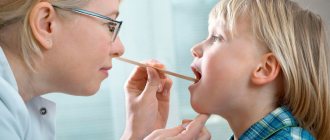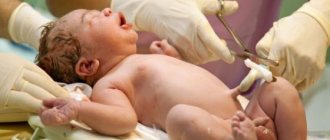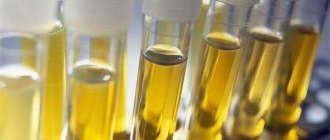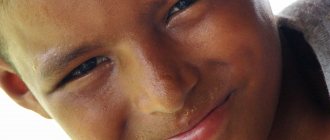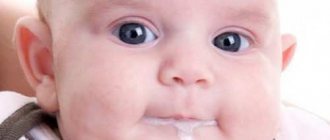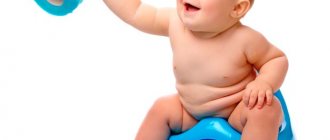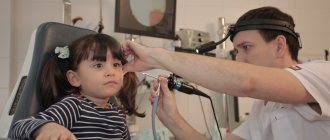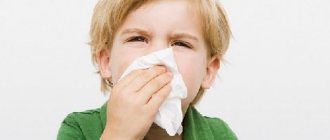The main causes of pain in the frontal region
In children, in 9 out of 10 cases, cephalgia is associated with overexertion. Despite the statistics, it is important to understand that the remaining percentage is due to pathological causes that require timely diagnosis.
Infectious diseases
When a child has a cold, not only does their forehead hurt, but they also experience a sharp rise in temperature (>39°C). The body affected by the virus is poisoned by toxins that provoke pain.
In addition to high fever and cephalgia in the forehead and temples, the following appear:
- pain and sore throat (the child begins to cough);
- muscle weakness;
- redness of the eyes;
- rhinitis;
- loss of appetite;
- pronounced reaction to light;
- feeling of chills.
To avoid complications, it is important to exclude physical activity and ensure proper rest with mandatory bed rest.
Sinusitis
Inflammation in the maxillary sinuses occurs as a complication of diseases of viral etiology.
You can recognize the disease in a child by the following symptoms:
- The headache is most severe in the forehead area;
- pain is aggravated by tapping on areas near the nose and trying to tilt the head;
- against the background of the inflammatory process, the temperature rises;
- mucous or purulent discharge flows from the sinuses;
- There is pressure and tension in the upper part of the face caused by accumulated pus pressing on the nerves.
Interesting: Headaches in a teenager: what to do and how to treat?
Accumulated purulent masses can infect the brain. If your forehead hurts and the feeling of fullness increases, call a doctor.
Frontit
Inflammation during frontal sinusitis affects the mucous membranes of the brain and is accompanied by chills, weakness and aches against the background of toxin poisoning. The child has:
- forehead hurts and temperature rises;
- the affected area swells and turns red (the area of the sinuses or brow ridges);
- stuffy nose;
- there is pressure on the eyeballs;
- tearfulness and photophobia appear;
- Symptoms increase immediately after waking up and when trying to tilt your head.
Brain concussion
It may hurt in the frontal area after receiving injuries or bruises. In case of a concussion it is noted:
- short-term loss of consciousness lasting no more than 5 minutes;
- tearfulness or delayed reaction after waking up;
- dizziness and feeling of nausea.
To avoid any consequences, it is recommended that the victim be seen immediately by a doctor. If you miss the necessary therapy, then headaches in the forehead area may appear in the child several years later on an ongoing basis.
Tension headache
Most often, school-age children suffer from cephalalgia associated with overexertion. In addition to the unusual mental load, the emotional stress associated with adaptation to an unfamiliar team plays a big role.
The pain syndrome is recorded in the 2nd half of the day, accompanied by:
- lack of appetite;
- dizziness;
- sudden mood swings.
- feeling of nausea.
The child has pain not only in the forehead, but in other areas. There is a feeling of being squeezed by a tight hoop.
Migraine
Migraines are inherited and occur in first-graders and teenagers. In primary schoolchildren, the disease does not depend on gender, and at the age of 14 it is more often registered in females.
Interesting: Why does an 11-year-old child have frequent headaches and what to do about it?
If a child has pain on only one side of the head, and a squeezing sensation of pain is noted in the forehead area, radiating pulsation to the temple, then the likelihood of a migraine is high. In addition to the main symptom, the following is noted:
- lethargy and drowsiness;
- attacks of nausea, accompanied by vomiting and subsequent improvement;
- fear of light and noise;
- spatial disorientation.
Increased intracranial pressure
Intracranial hypertension is a condition characterized by the pressure of excess cerebrospinal fluid accumulation on brain receptors.
The increase in pressure inside the skull is explained by:
- tumors or inflammation of the brain;
- hydrocephalus;
- cerebral hypoxia;
- disruption of metabolic processes associated with vascular spasms;
- traumatic brain injuries;
- reaction to drug treatment;
- intoxication of the body caused by infections or poisoning.
For intracranial hypertension:
- swelling of the face and subcutaneous pressure occurs;
- severe headache in the temples and forehead, stuffy ears;
- vision and appetite deteriorate;
- the temperature rises, dizziness occurs;
- general activity decreases.
The pain syndrome intensifies in a supine position, which disrupts daytime and night sleep.
Teething
The appearance of the first teeth is accompanied by headaches, a slight increase in temperature and swollen gums. The baby begins to be capricious and refuse to eat.
Pain during teething is accompanied not only by baby teeth, but also by molars, so even teenagers face this problem.
If a 9 year old child has a headache, what does it mean?
Options 3:
- Tired, nervous.
- Started to get sick (FLU, respiratory infection)
- This is a symptom of the disease (pain recurs regularly).
Let's look at some diseases in detail.
Intracranial pressure disorder
Occurs as a result of the accumulation of cerebrospinal fluid and its pressure on brain structures. This is not an independent disease, but a symptom of another pathology, a malfunction of the body. Headache with ICP is accompanied by:
- Drowsiness.
- Absent-mindedness, memory impairment.
- Poor coordination of movements.
- Dark spots before the eyes.
- Deterioration of vision.
The presence of symptoms is a reason to contact a pediatric neurologist.
Viral and infectious diseases
If a child has bright catarrhal manifestations (cough, runny nose, sore throat), the headache is associated with an inflammatory process and an increase in temperature. The parents of a 9-year-old child know how to act in this situation. Sometimes the temperature simply rises to 38 and above, while the throat and nose do not make themselves felt. Catarrhal symptoms appear on days 2-3. Antipyretics will help relieve headaches.
Meningeal headaches
Meningitis affects the brain. It is caused by viral or bacterial infections. The pain is intense, attempts to turn the head provoke vomiting. The condition gets worse:
- Fever. The temperature is above 39 degrees, it doesn’t work well.
- Clouding of consciousness.
- Ringing in the ears.
- Rash.
Infection leads to serious complications and death.
Poisoning
The presence of vomiting and diarrhea often indicates poisoning. If other family members have symptoms, and the diet included a product whose quality or freshness you doubt, the cause of the headache is clear. When poisoned, toxins enter the brain, causing corresponding sensations. Vomiting causes overstrain of the blood vessels in the head.
Poisoning with neurotoxins is much more dangerous. There are cases when children at school or in the yard tried henbane, mushrooms, etc. At this moment, it does not matter where they got them. If poisoning is accompanied by nervous symptoms: confusion of speech, rolling of the eyes, convulsions, call an ambulance, and then try to find out what exactly the child ate (drank).
Inflammatory process in the trigeminal nerve
The trigeminal nerve is responsible for transmitting nerve impulses to the face. It has 3 branches, located in the area of the lower and upper jaw, forehead. With inflammation, the pain is sharp, lasts 30-40 seconds and goes away. Repeats often. Additional symptoms:
- Increased mucus production (tears, saliva, nasal fluid)
- Pain when brushing teeth or eating.
- Pupil dilation.
- Facial muscle spasms.
Interesting: Headache medications for children
The pathology is treatable and does not cause complications with adequate treatment.
Head and brain injury
After a fall from a height or a strong blow, you need to fix your head, try to stop the bleeding and wait for the doctors to arrive. The first desire of parents in such a situation is to pick it up and carry it. Such actions can cause death.
It happens that a child just hurt himself, got over it and continues to go about his business. And after a few hours or days a headache and nausea appear. It is imperative to see a doctor to rule out (confirm) a concussion.
Which doctors should I contact if I have pain in the forehead?
If your forehead hurts for a long time and your general condition worsens, contact your pediatrician or call an ambulance. The diagnosis is made based on the results:
- general urine and blood analysis;
- computed and magnetic resonance imaging;
- electroencephalography;
- X-ray of the skull.
Interesting: Headaches in a 9-year-old child: causes, diagnosis, first aid
Depending on the reason explaining the cephalalgia, the patient is redirected to:
- ENT;
- ophthalmologist;
- psychotherapist;
- neurologist;
- dentist;
- surgeon;
- oncologist.
As a rule, therapy is based on taking medications to relieve pain and physical therapy to improve immunity.
Psychological disorders and problems
Sometimes the headache is psychosomatic in nature. This may be a reaction to conflicts in the family, lack of attention from parents, or overwork. The child is not pretending, everything happens on a subconscious level. You can recognize this phenomenon by observing when the pain appears and disappears.
If cephalgia is accompanied by obvious behavioral abnormalities (running away from home, pugnacity, theft), this may be a manifestation of mental disorders.
Headaches occur in all age groups. If this is an isolated case, and the sensations are not too pronounced, there is no need to sound the alarm.
Causes that can be easily eliminated at home
If a child has a pain in the forehead, temples, or the whole head is splitting, do not panic and try to figure out the root cause. Some factors that cause cephalalgia can be dealt with on your own:
- Psychological discomfort. Constant feelings of stress are relieved with relaxing herbal infusions and aromatherapy. If the forehead and temporal area hurt for a long time, then brew herbal tea or take a warm bath with the addition of aromatic oils.
- Oxygen starvation. With long walks and mandatory ventilation of the room, your head will hurt much less.
- Fatigue and muscle fatigue. Avoid being too busy. If after school your child comes tired and complains of pain and fainting, then refuse the additional sections.
- Poor nutrition. Eating fast food leads to impaired blood circulation in the vessels of the brain. Adjust your diet and eliminate unhealthy snacks.
The basis for treating these problems is adherence to the regimen. In addition to normalizing your diet, avoiding sleep deprivation and maintaining physical activity, use:
- cooling (for the forehead and temples) or warming (for the neck and back of the head) compresses;
- approved painkillers (Glycine, Paracetamol);
- mint, grapefruit or lemon oils for rubbing the temporal area.
For your child’s health, see doctors regularly for preventative purposes. For cephalgia in children under one year of age, it is better to seek help immediately. Due to low immunity, infants are more difficult to tolerate any disease, so even ARVI can cause unwanted complications.
Headache Treatment Methods
Treatment methods cannot be definitely named, because they will depend on the results of the examination and diagnosis.
Let's look at the main causes of hypertension and their treatment:
- if the head hurts due to nervous tension or emotional breakdown, the child is prescribed a course of sedatives, for example, Noobut, and vitamins (Magne-B6, calcium, magnesium, zinc)
- when the cause is hypertension or other pathologies of the vascular system, it is necessary to focus on cleaning blood vessels and normalizing the heart rate
- if a headache develops against the background of an infectious disease, antiviral, antifungal or antibacterial drugs are required
In addition to treatment, it is imperative to provide the child with restful and sound sleep, a “healthy” and positive environment at home, walks, and proper nutrition.
In addition to taking medications, you can drink a course of soothing tea based on chamomile, valerian or sage. Medicinal plants will help normalize the functioning of the central nervous system and increase the body's protective functions.
When is surgery required?
Surgical intervention is prescribed in case of injury, neoplasm, meningitis and other pathologies that cannot be treated with conservative methods. Modern medicine, and specifically surgery, makes it possible to almost completely carry out an operation to stop a disease or adhesions of nerve endings, which allows you to get rid of the disease once and for all.
You can learn more about what to do if your child has a headache from the video:
Walking, bathing and baby mode at a temperature of 39℃
If the temperature is high, an 8-year-old child does not need full water procedures. Taking a bath is not recommended. But hygiene procedures are mandatory for a small patient. It is enough to wipe and wash the child. This will wash away sweat and other skin impurities. Clean skin will make you feel better.
Walking in this condition, even in good weather, is prohibited. A child with a temperature of 39℃ is prescribed bed rest. However, fresh air is extremely important, so the room where the patient is located needs to be ventilated as often as possible.
A temperature of 39℃ in a child is not critical, but if it is accompanied by a headache, then you cannot waste time and do nothing. You need to go to the hospital, undergo an examination and begin immediate treatment.
Why children may have headaches in the forehead area
- 1 Reasons
- 2 When to see a doctor?
- 3 What to do?
Usually, through pain, the body tries to tell us that something is wrong with it. Unfortunately, he has no other ways to inform us about an impending illness, so it is up to us how quickly we react and can maintain our health.
The situation becomes more complicated when a child gets sick. In most cases, the baby cannot really explain what is hurting him, so mothers mistakenly believe that everything is fine with him and he is just being capricious.
One of the most reliable signals from the body about possible problems in its functioning is considered to be a headache in the frontal region, from which, contrary to popular belief, children also suffer.
Causes of illness
When a child has a headache, it may be a sign of one of the following conditions:
- any infectious diseases;
- inflammation of the sinuses;
- head and neck trauma;
- anemia;
- stressful situations;
- pathology of the digestive tract – gastritis, duodenitis;
- eye diseases with visual impairment;
- severe allergic reactions;
- posture disorders.
With infections of the nasopharynx, damage to the meninges or other organs, pain is a consequence of intoxication; it rarely occurs without fever and is accompanied by other signs of an infectious disease.
Pain in the forehead area due to increased intracranial pressure
Children with migraines often have a hereditary predisposition, and their parents may suffer from this pathology for many years. Malaise appears within 24 hours after the action of trigger factors, which may include:
- fatigue;
- some food products;
- weather changes;
- stress;
- hunger.
A head injury can lead to the development of a brain contusion or concussion of varying severity. Brain swelling and hemorrhage lead to pain. It often persists or periodically worsens after recovery.
In school-age children, pain is provoked by mental stress and emotional stress. Children with excessive demands on themselves or from parents who try to justify them are susceptible to the appearance of unpleasant symptoms. During adolescence, when the nervous system is developing, headaches may appear more often. Moderately severe sensations 1-2 times a month are not a cause for concern.
Sometimes headaches go away after eating candy or sweet tea. If the child drinks a lot and urinates frequently, this may be a sign of diabetes.
What you can and cannot do with a high fever and headache
A cabbage leaf will help lower your temperature before the doctor arrives.
Before going to the doctor, it is forbidden to give your child any medications. This will complicate diagnosis and smooth out the clinical picture of the underlying disease.
What you can do:
- apply a cool compress to the forehead or replace it with a cabbage leaf, on which apply grated raw potatoes;
- make a decoction or infusion based on medicinal herbs (chamomile, motherwort, valerian, hawthorn);
- remove all sources of loud sounds and bright lights from the child’s room (dim the lights);
- open a window or vent in the room for ventilation;
- if there is vomiting, the child should be placed on his side to avoid vomit entering the respiratory tract.
It is prohibited in case of elevated temperature and headache in a child:
- the use of mustard plasters and warming alcohol compresses;
- the use of alcohol-containing solutions and cold water to reduce temperature;
- gastric lavage for a newborn baby before the doctor arrives;
- taking a warm bath (an alternative to bathing is wiping with a damp cloth).
Meningitis rash can spread throughout the body
Dangerous symptoms that should cause you to immediately call a doctor:
- strengthening of the clinical picture after taking an antipyretic drug;
- vomit;
- severe abdominal pain;
- disturbance of consciousness;
- convulsive syndrome;
- skin rash;
- swelling of the fontanelle in a newborn;
- change in urine color.
The doctor prescribes specific therapy based on the cause of the symptoms.
Migraine in a child
The diagnosis of migraine can only be established after excluding other possible causes of headaches in a wide range of options: from inflammatory diseases of the meninges or sinuses, to visual and spinal disorders, the consequences of trauma, and even intracranial bleeding or brain tumors.
Considering the above and the risk of serious illnesses, we can once again emphasize that headaches, first of all, should be considered as a symptom of the disease, and not the disease itself. If a doctor, after a thorough examination of a sick child, diagnoses migraine (headache is caused mainly by poor circulation in the vessels of the meninges), appropriate treatment is prescribed. Currently, there are a number of effective therapeutic methods for the acute phase (relief of the attack, including accompanying symptoms) and prevention of migraine.
Treatment should be entrusted to a specialist. Of course, you cannot self-medicate (i.e., treat by parents). Instead of conventional analgesics, specific drugs in doses adapted to the child’s body are more suitable for use.
Diagnostic methods
To understand why your child has a headache, it may be necessary to undergo a professional diagnosis. Only a doctor can refer for specific examinations after learning about the disturbing symptoms and examining the child. The list of studies will depend on what complaints the person has. If you are worried about more than just a headache, then you will have to see additional specialists.
It will be necessary to study the state of the child’s brain. This is required in order to eliminate the possibility of serious pathologies. The doctor may order a magnetic resonance imaging scan, which provides a large amount of information about the condition of the cranium. Even young children can undergo the test, but if they are unable to lie still, then anesthesia may be necessary.
Computed tomography is often used, and an X-ray of the skull is also taken. These studies also allow us to learn about the state of the brain. With their help, it will be possible to exclude such serious pathologies as a tumor, hematoma and aneurysm. Additionally, the child will need to donate blood for a general analysis, as well as urine. Then it will be possible to clearly judge the presence of abnormalities in the body.
Based on the diagnostic results, it will be possible to understand what condition the child is in, as well as whether he has serious deviations. If you have diseases, you will have to undergo a course of treatment. Specific measures depend on what violations were encountered.
Provoking reasons
Painful sensations in the head often disturb children due to external factors. In particular, the condition is affected by an incorrect lifestyle, so parents need to carefully reconsider their daily routine. For example, severe fatigue can cause a child to have a sore forehead. It is quite possible that the child has to study too much and go to clubs, which is why there is not enough time to rest. For this reason, it is important for adults to ensure that the minor gets enough rest.
Other reasons:
- Head injury. Often the frontal area may hurt when the baby has injured his head. This could be a regular bruise, or a concussion, or even a fracture. Once there has been damage, it is extremely important to monitor the child's condition and ensure that it does not worsen.
- Stress. A child should not constantly experience nervous tension, because this will affect his well-being. Stress can be in kindergarten, school, or even at home. If unpleasant symptoms are provoked by nervous overstrain, then it is important to calm the baby down, and the pain will go away on its own.
- Poor nutrition. It is extremely important for your baby to eat properly in order not to experience headaches. You should limit the amount of processed meats, sugary drinks, cheese, nuts, chips, and seafood. It will be beneficial for your child to eat more vegetables, fruits, dairy products and cereals.
- Allergic reaction. For some people, allergies are accompanied by painful sensations in the head. It is important for parents to ensure that there are no other symptoms such as hives, runny nose or swelling.
- Muscle fatigue. Pain in the neck and forehead can occur when staying in one position for a long time, for example, at a desk or at a computer. Special exercises that will relax the muscles will help prevent this problem.
It should be understood that in some cases, headaches occur due to various diseases. Pathology can be suspected if the symptom occurs constantly and is difficult to eliminate. It would be useful for parents to consult a doctor in order to diagnose the disease in a timely manner. This is the only way to begin treatment immediately and save the baby from the unpleasant manifestations of the pathology.
Treatment
The fastest way to reduce pain in the forehead is to give your child a painkiller. Almost from birth, you can use medications containing ibuprofen and paracetamol. Moreover, they can be given not only when there is simply a headache in the frontal part, but also at elevated temperature.
But in addition to medicinal methods, there are folk recipes that often allow you to do without the help of drugs. When your child has a headache, you need to provide him with peace and put him to bed. You can place a cool compress on the child's head and a warm heating pad on the neck. This method is effective even for migraines. In addition, aromatherapy will also help the child calm down, relax and relieve painful sensations. Peppermint, lemon balm and rosemary oils can be added to the water that is intended to wet the cloth for a compress on the head. But you need to be sure that the oils will not cause an allergy, otherwise the pain may only intensify and be complemented by other unpleasant symptoms.
What needs to be done to make the correct diagnosis
Only an experienced specialist can understand the variety of reasons, but the doctor will also need the help of the child and his parents. Most likely, you will have to answer all of the questions listed below to find out exactly why your headache hurts and radiates strongly into the eye:
- how long ago the pain began, and what causes you suspect. For example, a recent illness, injury, etc.;
- are there any signs of impending pain (harbingers);
- pain occurs day or night;
- what additional symptoms occur when the eye hurts on one side;
- what you use to relieve your child's condition, how long the pain lasts and whether it goes away on its own.
Answers to these questions, as well as tests and other studies, will certainly help you find answers to all questions and develop a treatment strategy.
